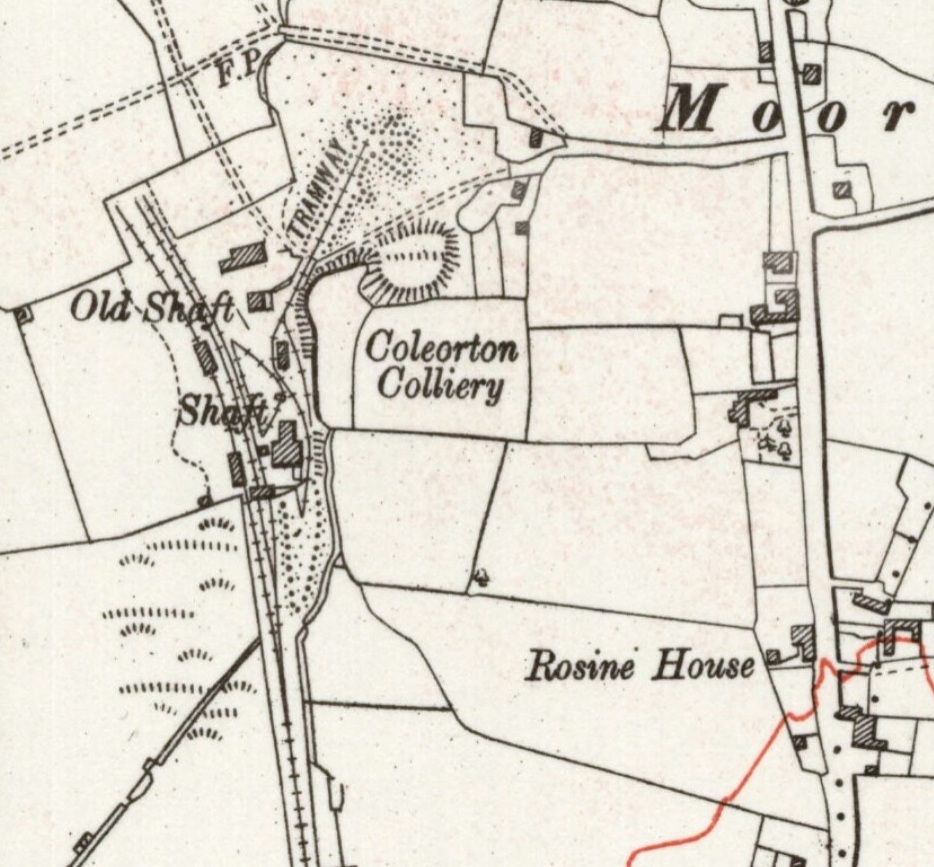COLEORTON COLLIERY (SK 398163)

OS Map, Leicestershire XVI.SE 1920
Reproduced by permission of the National Library of Scotland
Coleorton (New) Colliery, comprising two shafts was sunk in 1875 by G. Checkland & Co., a time when most of the collieries in the exposed part of the coalfield had closed or were on the brink of closure. The shafts were sunk to a depth of 105 yards, intersecting the Main Coal seam at 183 feet and the Roaster Coal at 312 feet from the surface. The thickness of these seams was 5 feet and 2ft. 10ins respectively.
During the early years of working the colliery, the Main, Stinking and Nether Lount seams were worked. It was discovered however, that most of the available coal in these seams had already been worked. In the 1880’s workable reserves of the Middle Lount and Roaster Seams were found. The 1890’s saw further reserves of Middle Lount, Nether Lount and Roaster Seams being leased but the colliery was in a shaky state financially being heavily in debt to the bank. It would appear also that the colliery was difficult to work.
In 1932 or 1933, the by now closed Coleorton Colliery was acquired by the Leicestershire Colliery & Pipe Co. Ltd, who were the owners of the nearby New Lount Colliery. Along with this came the leases of some 2000 acres of potential coal reserves, which were added to the New Lount Colliery reserves. It had been intended to use the Coleorton Colliery as a pumping station but within a few months the shafts had collapsed. They were later filled in.
The National Coal Board in 1952-53 put down a drift from the old Coleorton Colliery site. This was intended to provide a new ventilating circuit and an alternative emergency exit for New Lount Colliery. The drift was graded at 1 in 4 and was formed with 11ft. x 9ft. steel arch supports.
Near the intended bottom of the drift, connection was made into an existing roadway in the Nether Lount Seam and the drift itself was continued until it intersected the Yard Seam. The Yard Seam was still unworked in this locality. Between the Nether Lount intersection and the Yard Seam, the floor of the drift was concreted and used as a pumping sump for water entering the drift.
In this area the Yard Seam dipped to the East at 1 in 15 and averaged 2ft. 8in. thickness. The seam was underlain by a bed of clay 3ft. 3in. thick of which the top 16 inches was suitable for use at the Newbold pipe works.
The National Coal Board subsequently drew up proposals to work the Yard Seam and clay from the drift. The available workable area was bounded to the North by a fault which had been proved in the Middle Lount Seam, to the East by old Yard Seam workings of Coleorton Colliery, to the South by a boundary with Snibston Colliery and Westwards, to the rise, by the statutory 50 yards of cover limit. Estimated reserves were Coal – 374,868 tons and Clay (useable) 349,015 tons.
It seems unlikely that these drift working proposals ever came to fruition.
Fig. 04 – Site Plan of Coleorton (New) Colliery. From Ordnance Survey Map c.1923, Scale: 1/2500.
Copyright © NMRS Records: Geoff Hayes Collection
Return to previous page

